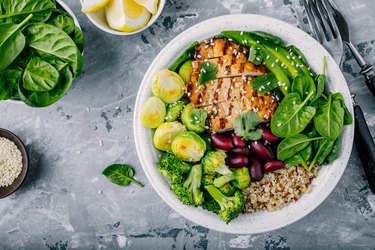
First things first: Toning up and losing weight aren't quite the same. Weight loss is more straightforward as it simply involves lowering your body weight, which can be done by dieting alone.
Toning, however, is a different, more complex matter. Although toning is the common term, what you're really looking for is a leaner, stronger-looking physique, which involves losing fat, rather than just overall weight loss.
Video of the Day
Video of the Day
Whether you're looking to lose weight or tone up, here's exactly how to design a gym routine and diet plan to help you reach your goals. Before long, you'll start to lean out and see the toned physique you're after.
Looking to lose weight for good? Noom gives you the support and tools you need to stay focused and achieve your weight-loss goals.
How to Create a Workout Plan and Stick to a Schedule
Just like your diet, your gym schedule needs to be sustainable and realistic. Start by deciding how many days you can get to the gym each week. Ideally, you'll be able to exercise between three and six days per week. These workouts should include both strength and cardio.
Lift Weights to Tone Up
Strength training is your best tool when it comes to burning fat and sculpting muscle. Increasing your total muscle mass can help you maintain a healthy body weight, according to the American Council on Exercise (ACE). Plan to strength train each muscle group at least two times per week for the best results.
Total-body exercises, in which you work every major muscle group in one session, are the most efficient way to accomplish your strength training goals. Select several compound exercises, like deadlifts, squat thrusts or renegade rows, for each workout to ensure you're hitting all the muscle groups, the ACE recommends.
In order to build muscle, you'll need to bake in adequate recovery between your strength sessions, too. It's best to avoid training the same muscle group on back-to-back days and allow your muscles to recover for 24 to 72 hours before your next workout, according to the ACE.
If you lift the same muscle group every day, you risk muscle overuse, which can increase your risk for injury. During recovery days, you can incorporate some low-impact activities, like easy walking or yoga.
Increase Calorie Burn With Cardio
If you want to burn more calories, cardio is necessary. You want to get at least 150 minutes of steady-state cardio, like walking, running and cycling, or about 75 minutes of vigorous activity, such as high-intensity interval training (HIIT), each week, according to the physical activity guidelines for Americans. Doing two HIIT days per week or several long walks can get the job done.
A Sample Weekly Workout Routine
- Monday: Full-body strength training workout
- Tuesday: Rest or active recovery
- Wednesday: 45-minute HIIT workout
- Thursday: Rest or active recovery
- Friday: Full-body strength training workout
- Saturday: Rest
- Sunday: 45-minute HIIT workout
Best Strength Exercises for Building and Toning Muscles

As mentioned above, compound exercises are one of the simplest ways to start your strength training regimen. Because they incorporate multiple muscle groups and joints, these moves will burn more calories, improve your coordination, boost your heart rate and improve flexibility, according to the ACE.
But you can also create a workout that incorporates both compound movements and upper-body/lower-body isolation exercises. Isolation exercises help you build bigger muscles because they recruit all muscle fibers — slow-twitch and fast-twitch muscle fibers — which leads to greater muscle damage and growth.
Remember, the goal is to train all your muscles if you're only going to be strength training about two days per week. As you build your program, consider this sample workout, courtesy of Carolina Araujo, a certified personal trainer.
Full-Body Strength Workout
- Dynamic warm-up routine
- Squat press: 8 to 10 reps x 4 sets
- Push-ups: 8 to 10 reps x 4 sets
- Deadlifts: 8 reps x 4 sets
- Up and down plank: 10 reps x 4 sets
- Hip thrust: 10 reps x 4 sets
- Arnold press: 12 reps x 4 sets
- Chest press: 10 reps x 4 sets
- Bent-over row: 10 reps x 4 sets
Best Cardio Exercises for Weight Loss

Although cardio won't help change your body composition (your body's ratio of muscle and fat), it can help increase your overall calorie burn. Plus, cardio exercise is important for your overall heart health. Walking, jogging or steady biking for about 150 minutes per week, or 30 minutes for five days a week, is enough to fulfill your weekly cardio quota, per the physical activity recommendations.
But if calorie burn and strength gain are the goal of your cardio sessions, HIIT training is probably the best way to go. This type of exercise involves alternating between intervals of intense movement and brief periods of rest. Many popular HIIT exercises are also strength-based, like burpees and jump squats. So, you'll be able to burn calories while preserving muscle (a win-win).
Eating Smart for Fat Loss

No matter how much you exercise, you can't totally neglect your diet either. To lose weight, you'll need to create a calorie deficit, which is when you burn more calories than you consume, according to the Mayo Clinic.
You may feel tempted to follow a strict diet for faster results, but most health professionals suggest sticking to a slower weight-loss rate — no more than 1/2 to 2 pounds a week — according to Johns Hopkins Medicine. Losing weight slowly will also help ensure you keep as much muscle mass as possible.
To create a sustainable calorie deficit, first track how many calories you're eating each day to maintain your current weight, aka your maintenance calories. You can do this by tracking your food and weight across several weeks, using a food diary or app.
Once you've figured out your maintenance calories, you can gradually limit your calorie intake to create a deficit. You can safely cut about 500 calories per day to lose about one pound each week, explains the Mayo Clinic.
Replacing some of the processed foods in your diet is the easiest way to get in a deficit. Chips, sweetened beverages and sweets are high in calories but low in nutrients, leaving you hungry and craving more.
Instead, focus on eating nutrient-dense foods, as they will help fuel your workouts and keep your muscles strong and lean. Fill your plate with plenty of veggies, whole grains, healthy fats and lean protein, such as chicken, fish, grass-fed beef, eggs, dairy and beans and legumes.
- American Council on Exercise: "Strength Training 101"
- American Council on Exercise: "Benefits of Compound Exercises"
- Mayo Clinic: "Counting Calories: Back to the Weight-Loss Basics"
- American Council on Exercise: "How to Select the Right Rest Intervals and Post-Training Recovery for Your Clients"
- Physical Activity Guidelines for Americans
- Johns Hopkins Medicine: "Benefits of maintaining weight loss"
Was this article helpful?
150 Characters Max
0/150
Thank you for sharing!
Thank you for your feedback!